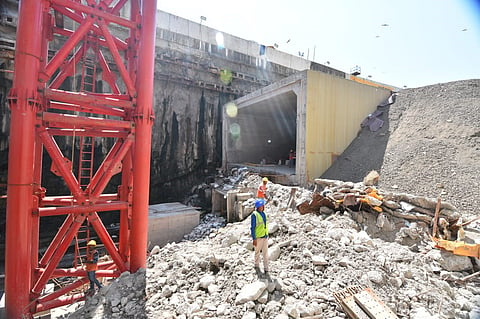BMC To Highlight Coastal Road Project's Disaster Resilience At G-20's 2nd Disaster Risk Reduction Working Group Meeting
Mumbai, May 14 (TNA) The Coastal Road, which is counted as one of the most significant upcoming infrastructure projects of Mumbai, will be a part of deliberations in the upcoming G-20 2nd Disaster Risk Reduction Working Group (DRRWG) Meet in Mumbai from May 23-25, 2023. The Brihanmumbai Municipal Corporation (BMC) will highlight the disaster management measures taken for this project in front of the DRRWG delegates. The DRRWG's five key priorities are early warning, resilient infra, national response, building back better and nature-based solutions.
The construction of the 10.58 km long Coastal Road Southern Section from the Princess Street Flyover on Shyamaldas Gandhi Marg to the Worli side of the Worli Bandra Sea Link is currently in full swing and, so far, 73.5 percent of the work on the project has been completed under the supervision and guidance of Commissioner and Administrator of Brihanmumbai Municipal Corporation Dr. Iqbal Singh Chahal and Additional Municipal Commissioner (Eastern Suburbs) Ashwini Bhide.
It is coming up on a reclaimed area of 119 lakh 47 thousand 940 square feet (111 hectares) and will be an addition to Mumbai’s 250 Km road network.
Speaking about the project, Bhide said, the project design has factored in the probable disasters, apart from environmental compliances and ease of living for citizens. About 13.6% of project area i.e. 15,60,770 square feet (14.50 hectares) is earmarked for the construction of safety wall which will protect against sea waves.
The 8.5 km long sea wall is built in such a way that marine life flourishes, while corrosion, soil erosion and tidal effects are taken care of. This will also be an important issue for disaster management matters. For the construction of the wave wall, which will act as a protection wall, the highest level of flood has been taken into account. It is going to act as a protection to the city from flood and storm surges. These are going to be beneficial not just to the coastal road, but to that section of the city as well.
Besides, all necessary fire protection measures have been provided for in the project. The 2 km long twin-tunnels have all provisions for fire-safety. Saccardo ventilation system provided with the tunnels will improve ventilation and air flow.
Hence, in case of a fire incident in one tunnel, the other will remain smoke-free. The whole structure is built in a manner to resist 100 MW fire for three hours! There would be fire retardant materials and fire boards provided in a way to resist a temperature of 1200 degree C for three hours.
Factoring in the floods and other related disasters, the project gave a chance to improve the Storm water Drainage Network of Mumbai. Since some areas have been added to the city landmass because of the reclamation, the existing Storm water Drainage network was extended beyond the sea wall.

